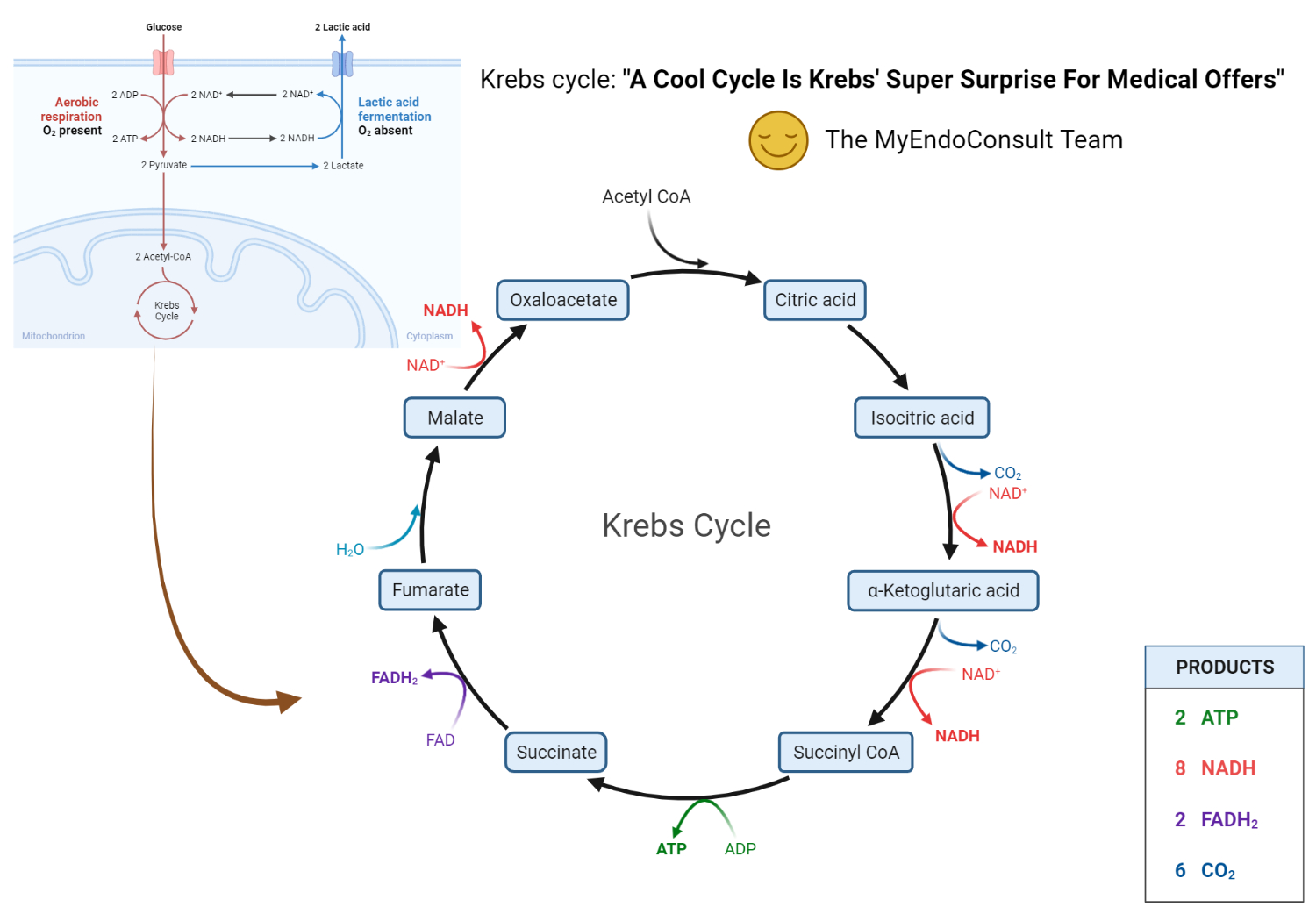Krebs cycle: "A Cool Cycle Is Krebs' Super Surprise For Medical Offers"
A - Acetyl CoA (A)
C - Citrate (Cool Cycle)
I - Isocitrate (Is)
K - α-Ketoglutarate (Krebs')
S - Succinyl-CoA (Super)
S - Succinate (Surprise)
F - Fumarate (For)
M - Malate (Medical)
O - Oxaloacetate (Offers)
Steps of Krebs Cycle
Now let's outline the steps of the Krebs cycle:
- Acetyl-CoA (2 carbons) combines with oxaloacetate (4 carbons) to form citrate (6 carbons). This reaction is catalyzed by citrate synthase.
- Citrate is converted to cis-aconitate, and then to isocitrate by aconitase, involving a dehydration and hydration step.
- Isocitrate is converted to α-ketoglutarate (5 carbons) by isocitrate dehydrogenase. This step involves the removal of a carbon dioxide molecule and generates one NADH.
- α-Ketoglutarate is converted to succinyl-CoA (4 carbons) by α-ketoglutarate dehydrogenase. This step also involves the removal of a carbon dioxide molecule and generates one NADH.
- Succinyl-CoA is converted to succinate by succinyl-CoA synthetase. This step generates one molecule of GTP (which can be converted to ATP).
- Succinate is converted to fumarate by succinate dehydrogenase, and one FADH2 is generated.
- Fumarate is converted to malate by fumarase, which adds a water molecule across the double bond.
- Malate is converted to oxaloacetate by malate dehydrogenase, generating one NADH in the process.
At the end of one cycle, one acetyl-CoA has been completely oxidized, yielding 3 NADH, 1 FADH2, and 1 GTP (or ATP). The oxaloacetate is regenerated and can combine with another acetyl-CoA to start the cycle again.
Krebs Cycle Diagram: Recalling Important Steps

Recalling the Enzymes of Kreb’s Cycle
Here's a mnemonic that uses the first letter of each enzyme involved in the Krebs cycle: "Cool Aunts In Kansas Sell Special Fudge Monthly."
C - Citrate synthase (Cool)
A - Aconitase (Aunts)
I - Isocitrate dehydrogenase (In)
K - α-Ketoglutarate dehydrogenase (Kansas)
S - Succinyl-CoA synthetase (Sell)
S - Succinate dehydrogenase (Special)
F - Fumarase (Fudge)
M - Malate dehydrogenase (Monthly)
This mnemonic uses the first letter of each enzyme to create a more intuitive and memorable phrase, making it easier to recall the enzymes associated with each step of the Krebs cycle.
Clinical Applications of Kreb's Cycle
The Krebs cycle, also known as the citric acid cycle or the tricarboxylic acid cycle, is a central metabolic pathway that plays a crucial role in cellular respiration and energy production. Understanding the Krebs cycle has several clinical applications, including:
- Inborn errors of metabolism: Deficiencies in enzymes involved in the Krebs cycle can lead to various metabolic disorders, such as deficiencies in the pyruvate dehydrogenase complex, fumarase, or α-ketoglutarate dehydrogenase. Early identification and management of these conditions can improve patient outcomes.
- Cancer metabolism: Cancer cells often exhibit altered metabolism, including changes in the Krebs cycle. For example, some cancer cells rely on aerobic glycolysis (the Warburg effect) rather than oxidative phosphorylation for energy production. Understanding these alterations can help develop targeted cancer therapies.
- Mitochondrial disorders: The Krebs cycle occurs within the mitochondria, and mitochondrial dysfunction can impact the cycle's efficiency. Mitochondrial disorders can result from genetic mutations or acquired factors, and understanding the role of the Krebs cycle in these conditions can guide treatment strategies.
- Exercise physiology: The Krebs cycle plays a vital role in energy production during physical activity, particularly for aerobic exercise. Understanding the cycle's function can help optimize athletic performance and develop training strategies.
- Diabetic ketoacidosis (DKA): In patients with diabetes, impaired glucose metabolism can lead to an increased reliance on fatty acid oxidation and ketone body production, causing acidosis. Understanding the Krebs cycle can help identify the underlying metabolic changes and guide the management of DKA.
- Drug development and toxicology: Some drugs and toxins can inhibit specific enzymes in the Krebs cycle, leading to cellular dysfunction or death. Understanding the cycle's function can help develop new drugs targeting specific metabolic pathways and assess the potential toxic effects of various compounds.
- Nutritional biochemistry: Understanding the Krebs cycle can help elucidate the metabolic pathways of various nutrients, such as carbohydrates, fats, and amino acids. This knowledge can guide dietary recommendations and the development of nutritional supplements for various health conditions.
Kindly Let Us Know If This Was helpful? Thank You!


